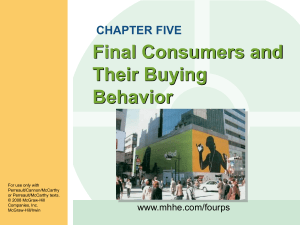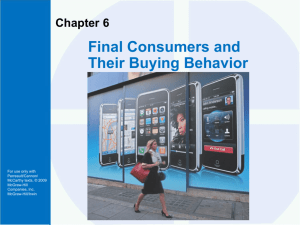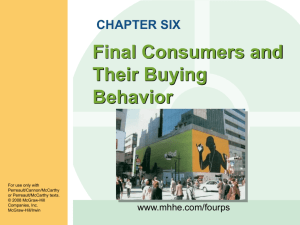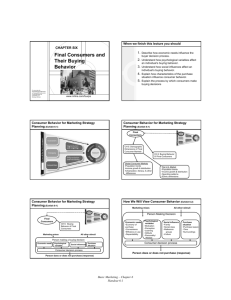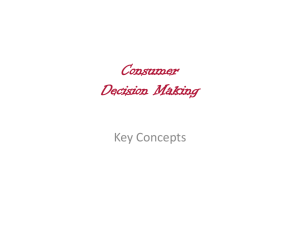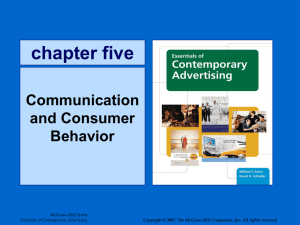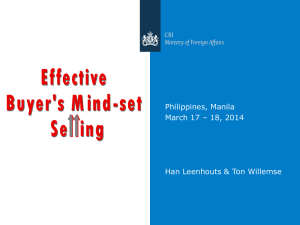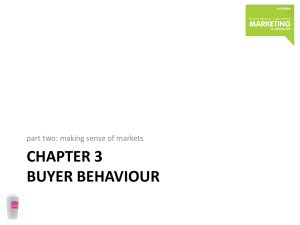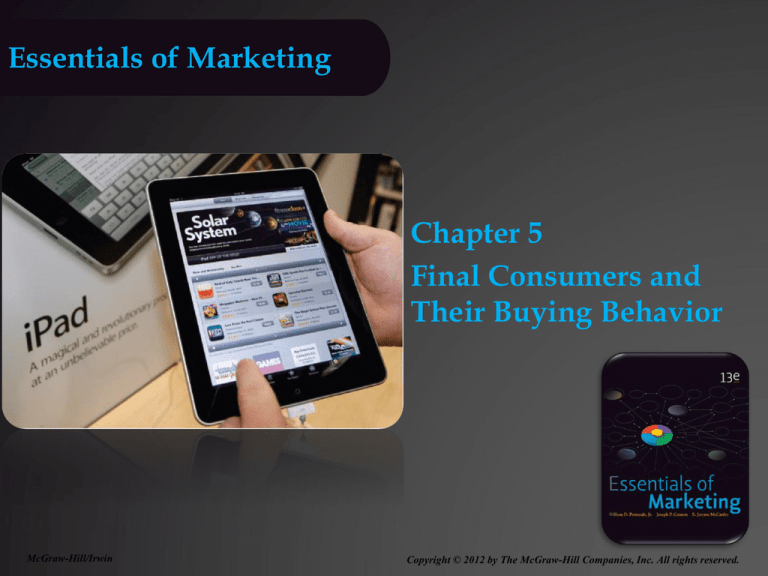
Essentials of Marketing
Chapter 5
Final Consumers and
Their Buying Behavior
McGraw-Hill/Irwin
Copyright © 2012 by The McGraw-Hill Companies, Inc. All rights reserved.
At the end of this presentation, you should
be able to:
1.
2.
3.
4.
5.
6.
Describe how economic needs influence the buyer
decision process.
Understand how psychological variables affect an
individual’s buying behavior.
Understand how social influences affect an
individual’s buying behavior.
Explain how characteristics of the purchase situation
influence consumer behavior.
Explain the process by which consumers make buying
decisions.
Understand important new terms.
5–2
Consumer Behavior for Marketing Strategy
Planning (Exhibit 5-1)
5–3
Consumer Behavior and Marketing Strategy
Planning (Exhibit 5-1)
Final
Consumers
CH 5: Final
Consumers and
Their Buying
Behavior
CH 6: Business and
Organizational
Customers and Their
Buying Behavior
Marketing mixes
All other stimuli
Person making decisions
Economic needs
Psychological
variables
Social influences
Purchase
Situation
Consumer decision process
Person does or does not purchase (response)
5–4
A Model of Influences on Consumer
Behavior (Exhibit 5-2)
Marketing mixes
All other stimuli
Person making decision
Economic needs
• Economy of
purchase
• Convenience
• Efficiency in use
• Dependability
• Income
Psychological
variables
• Motivation
• Perception
• Learning
• Attitude
• Trust
• Lifestyle
Social influence
• Family
• Social class
• Reference
groups
• Culture
• Ethnic groups
Purchase
situation
• Purchase reason
• Time
• Surroundings
Consumer decision process
Person does or does not purchase (response)
5–5
Economic Needs
Affect Many
Buying
Decisions—But
They’re Not the
Whole Story
Courtesy of The Procter & Gamble Company.
5–6
Psychological Influences within an
Individual
Needs
Wants
Drives
Consumers seek benefits to match
needs and wants!
5–7
Possible Needs Motivating a Person to
Some Action (Exhibit 5-3)
5–8
The PSSP Hierarchy of Needs (Exhibit 5-4)
Personal
Needs
Social Needs
Safety Needs
Physiological Needs
5–9
Checking Your Knowledge
Ads for Haynes Jeep-Chrysler feature the slogan, “Come
to Haynes, where the fun begins.” This is an appeal to
the consumer’s:
A. physiological need.
B. safety need.
C. personal need.
D. social need.
E. information need.
5–10
A New Role for Yogurt
5–11
Interactive Exercise: Needs
5–12
Perception Determines What Consumers
See and Feel
Selective
Exposure
Selective
Retention
Selective
Perception
5–13
Checking Your Knowledge
Pat purchased a Ford Taurus, but traded it for another brand
before it was out of warranty because it constantly needed
repairs. Now, every time Pat sees an ad that mentions the
quality of Ford’s new vehicles all she can think about is the
problems she had with her Taurus. This an example of:
A. need-based thinking.
B. selective retention.
C. selective exposure.
D. selective perception.
E. psychographics.
5–14
The Learning Process (Exhibit 5-5)
Drive
Cues
Reinforcement
Response
5–15
Attitudes Relate to Buying
Attitude: A
Point of View
Building
Consumer
Trust
Meeting
Expectations
Is Important
Belief: An
Opinion
Key Issues
“Green”
attitudes and
beliefs
Changing
Negative
Attitudes
Ethical Issues
May Arise
5–16
Psychographics Focus
on Activities, Interests, and Opinions
Activities
Interests
Opinions
5–17
Lifestyle Dimensions (and some related
demographic dimensions) (Exhibit 5-6)
5–18
Family Life Cycle Influences Needs
(Exhibit 5-7)
5–19
5-20
Family Life Cycle
5–20
5-21
Interactive Exercise: Family Life Cycle
5–21
Social
Influences
Affect
Consumer
Behavior
Courtesy of The Procter & Gamble Company.
5–22
Simple Approaches for Measuring Social
Class in the U.S
Occupation
Education
Type of
Housing
Location of
Housing
Income Is Not the Main Determinant!
5–23
Other Social Influences
Reference Groups
Opinion Leaders
Culture
5–24
Checking Your Knowledge
Anime, the cartoon-like Japanese art form, has generated
significant interest among Generation Y consumers in the U.S.
Anime conventions occur frequently and the largest ones draw
more than 20,000 attendees. Anime fans, many in costume,
come to these conventions to shop, participate in anime
workshops, and to simply hang out with people with similar
interests. Promotion of these conventions capitalizes mainly
on:
A. learning.
B. psychological needs.
C. selective processes.
D. reference group influences.
E. culture.
5–25
Individuals Are Affected by the Purchase
Situation
Purchase
Reason
Time Available
Physical
Surroundings
5–26
An Expanded Model of Consumer Behavior
(Exhibit 5-8)
Marketing mixes
Economic needs
All other stimuli
Psychological
variables
Social influences
Purchase
situation
Consumer decision process
Need
awareness
Routinized response
Problem solving
Purchase
decision
• Information search
• Identify alternatives
• Set criteria
• Evaluate alternatives
Experience
after the
purchase
Postpone decision
Feedback based on experience
5–27
Problem Solving Continuum (Exhibit 5-10)
Low involvement
Frequently purchased
Inexpensive
Little risk
Little information needed
Routinized
Response
Behavior
Low involvement
High involvement
Infrequently purchased
Expensive
High risk
Much information desired
Limited
Problem
Solving
Extensive
Problem
Solving
High involvement
5–28
Limited or
Extensive
Problem
Solving?
Courtesy of The Procter & Gamble Company.
5–29
Adoption Process Steps
Awareness
Interest
Evaluation
Trial
Decision
Dissonance
may set in
after the
decision!
Confirmation
5–30
Problem Solving
5–31
Checking Your Knowledge
Alice was a bit unsure about her decision after buying a new
car. Her uneasiness was diminished after receiving a
congratulatory note from the owner of the dealership. The
note contained a coupon stating that her first scheduled
maintenance on the vehicle would be free. These tactics are
part of the dealer’s strategy to reduce:
A. dissonance.
B. low involvement purchasing.
C. routinized response behavior.
D. social influences.
E. information search.
5–32
You should now be able to:
1.
2.
3.
4.
5.
6.
Describe how economic needs influence the buyer
decision process.
Understand how psychological variables affect an
individual’s buying behavior.
Understand how social influences affect an
individual’s buying behavior.
Explain how characteristics of the purchase situation
influence consumer behavior.
Explain the process by which consumers make buying
decisions.
Understand important new terms.
5–33
Key Terms
Economic buyers
Perception
Economic needs
Selective exposure
Discretionary income
Selective perception
Needs
Selective retention
Wants
Learning
Drive
Cues
Physiological needs
Response
Safety needs
Reinforcement
Social needs
Attitude
Personal needs
Belief
5–34
Key Terms
Expectation
Culture
Trust
Extensive problem solving
Psychographics
Limited problem solving
Lifestyle analysis
Routinized response behavior
Empty nesters
Low-involvement purchases
Social class
Dissonance
Reference group
Adoption process
Opinion leader
5–35

